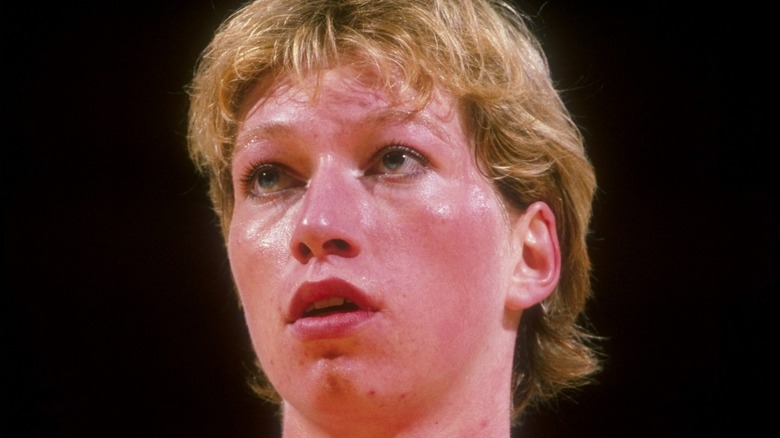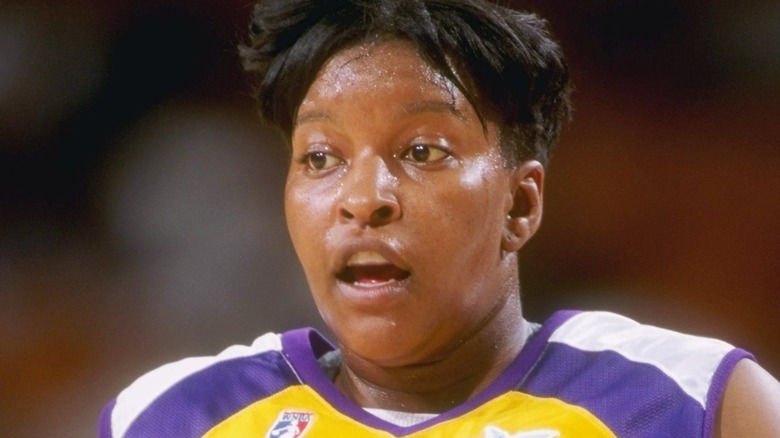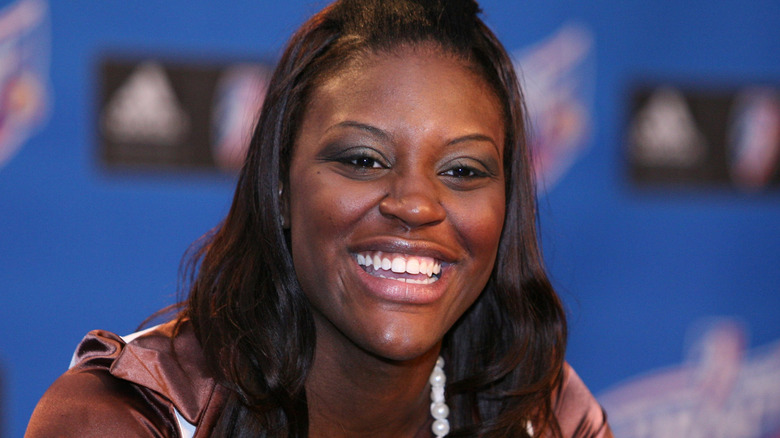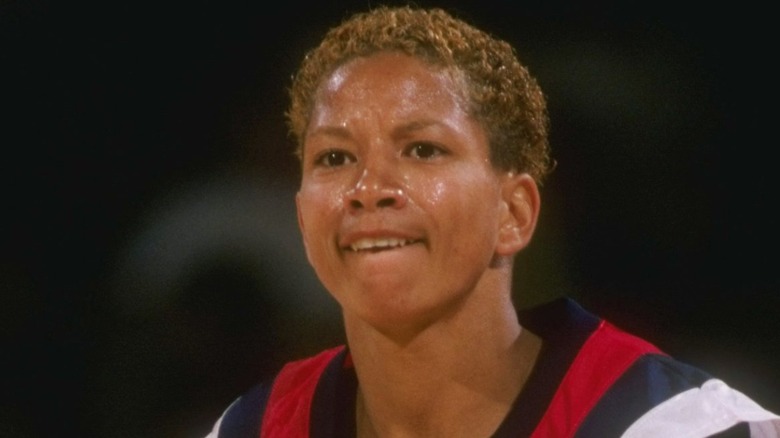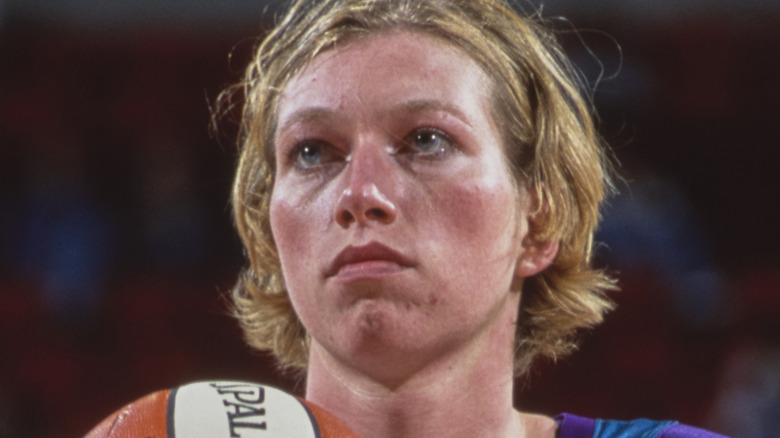Professional Female Basketball Players Who Died Before Turning 50
The Women's National Basketball Association is the longest-lasting, as well as the most visible and influential basketball league for women in U.S. history. It's made stars, household names, and Hall of Famers out of countless female hoopers, while also taking pro women's sports into the mainstream after years of being forced to the fringes of the culture. But the WNBA is just the latest and best-known women's basketball organization. Its 25-year history is the ongoing culmination of nearly a century of great basketball, played by women in high school and college programs, the Amateur Athletic Union, and short-lived leagues in North America (particularly the American Basketball League), as well as on a worldwide stage in European professional organizations and in the Olympics.
Like any other tight-knit and specific profession, women's basketball has its legends, athletes whose legacies will outlast their brief time on Earth, particularly those who died far too young. Here are some notable top-level basketball players of the past who died far too young.
Daedra Charles-Furlow
In 2006, ESPN named Daedra Charles (later Charles-Furlow) to its list of the 25 best collegiate women's basketball players of the previous 25 years. Playing for the University of Tennessee's Lady Vols from 1988 to 1991 (per the Knoxville News Sentinel), during which time she scored 1,495 points, pulled down 858 rebounds, blocked 97 shots, and led her team to two national championships. Her final collegiate game made history: The 1991 NCAA title game was the first to ever go into overtime, and Charles secured the win over Virginia with 19 points and 12 rebounds. That season, Charles-Furlow's' accolades included the SEC's female Athlete of the Year, and the Wade Trophy, given to the top women's college basketball player in the country.
After college, Charles-Furlow joined the U.S. national team and won a bronze medal in the 1992 Summer Olympics, then played overseas and spent the WNBA's inaugural season of 1997 with the Los Angeles Sparks. Inducted into the Women's Basketball Hall of Fame in 2007, Charles-Furlow coached at Auburn University, the University of Detroit, and the University of Tennessee.
During her final stint at her alma mater, Charles-Furlow was diagnosed with breast cancer. In April 2018, she died at age 49.
Tiffany Jackson
A standout for the Texas Longhorns, Tiffany Jackson racked up accomplishments in all four years of her college career, according to Sports Illustrated. In 2004, she was named the Big 12 Freshman of the Year and then made the All-Conference team and earned All-American honors for three straight years. Her stats were undeniable and point to her all-around abilities, excelling at offense and defense, too: Jackson is the first and only player in Texas women's basketball history to accumulate 1,000 points, 1,000 rebounds, 300 steals, and 150 blocks. In 2007, the 6'3" forward was selected fifth overall in the WNBA Draft by the New York Liberty, where she played for parts of four seasons before being traded to the Tulsa Shock, where she had a peak year in 2011, averaging 12.4 points and 8.4 rebounds a game, respectively. Jackson retired from the WNBA after a truncated 2017 stint for the Los Angeles Sparks.
During her pro career, Jackson was diagnosed with stage 3 breast cancer, according to Texas Sports. The disease went into remission in 2016 after treatment, allowing Jackson to play in the WNBA and Israel for a couple more seasons and raise awareness of breast cancer. On October 3, 2022, Jackson died from the effects of cancer. She was 37.
Kim Perrot
According to the Los Angeles Times, Kim Perrot was a sensational college basketball player at Southwestern Louisiana, setting 27 different all-time school records, including most points scored in a career. In a 1990 game against Southeastern Louisiana, Perrot scored 58 points, the second-most ever in an NCAA game to that point. Perrot played just two years in the WNBA, but they were an impactful two seasons. Averaging a total of 7.2 points and 2.6 steals for the Houston Comets in 1997 and 1998, the inaugural two seasons of the WNBA, Perrot helped lead her team to back-to-back league titles. In 1998, she finished in second place in the voting for Defensive Player of the Year.
The point guard didn't play in the Comets' 1999 title defense because she got sick. In August 1999, following a lung cancer diagnosis, Perrot died at the University of Texas M.D. Anderson Cancer Center in Houston, the Comets told the Associated Press. Perrot was 32.
Katrina Price
Nobody ever scored more points than Katrina Price did in the Stephen F. Austin women's basketball program, according to the New York Times. In her final year of college ball, Price was a third-team All-American, averaging 22.1 points and 5.3 rebounds per game, capping a career that included two recognitions as the Southland Conference's Player of the Year.
After her stellar college performance, Price made herself available for the WNBA Draft and played for team representatives but ultimately wasn't selected, instead given the chance to garner attention in a training camp for free agents. Instead, she declared for the WNBA's short-lived competitor, the American Basketball League (via Sports Illustrated). The Long Beach StingRays took Price with the seventh pick in the 1998 ABL draft, but the team folded, and then so did the league.
About a month later, in January 1999, police in Nacogdoches, Texas, responded to a call at an apartment building, where they discovered Price dead outside her sister's residence, apparently of a self-inflicted gunshot wound. Price was 23 years old.
If you or anyone you know is having suicidal thoughts, please call the National Suicide Prevention Lifeline by dialing 988 or by calling 1-800-273-TALK (8255).
Margo Dydek
According to Guinness World Records, the tallest woman to ever play in the WNBA was Margo Dydek, who stood 7'2". The Polish center played for six seasons in European leagues, starting when she was a teenager, before the WNBA took notice, inviting her to a pre-draft camp in 1998. A few months later, in the league's second-ever draft, Dydek was the #1 selection, her playing rights secured by the Utah Starzz.
During her rookie season, she averaged 12.9 points and 7.6 rebounds and set the individual season record for blocks with 114, which would stand for 16 years. The towering defensive force acquired the nickname "Large Marge" during her time with the Utah franchise, where she'd play for seven years before a trade to the Connecticut Sun in 2005. Not long after giving birth to her first child in 2008, Dydek walked away from the WNBA after a decade, having led the league in blocks nine times and was appointed to two all-star teams and two all-defensive teams. She's still the WNBA's all-time leader in blocks, with 877.
In May 2011, according to the Associated Press (via ESPN), Dydek suffered a heart attack and collapse in Brisbane, Australia. She was pregnant with her third child at the time. She lost the fetus, and doctors placed Dydek in a medically induced coma, but the basketball star never recovered. Dydek was 37 years old.
Corissa Yasen
Corissa Yasen was a three-sport superstar for Coeur d'Alene High School in the early 1990s. According to the Associated Press, teams led by Yasen won state championships in cross country, basketball, and track and field. In the latter, Yasen set an all-Idaho record in the high jump event, clearing a height of 5 feet, 10 inches. The inductee into the Idaho High School Athlete Hall of Fame participated in two sports at Purdue University, excelling in both. In 1996, she won the women's heptathlon event and was the starting forward on the school's basketball squad during her studies, named the college's female athlete of the year in 1995 and 1996.
When the WNBA launched in 1997, Yasen wasn't drafted, but she signed with the Sacramento Monarchs, becoming one of the league's first-ever players. She played in 19 games for the Monarchs in 1997, her sole season in the WNBA, averaging 2.7 points per game.
On May 12, 2001, after she didn't report for work for two days and friends and coworkers hadn't heard from her, her father Don Yasen conducted a wellness check and discovered his daughter deceased in her home in Coeur D'Alene, Idaho. According to the Purdue Exponent, a toxicology report found high or deadly levels of painkillers, anti-depressants, and mood stabilizers in Yasen's system, leading a coroner's report to establish the cause of death as an intentional drug overdose. Yasen was 27.
If you or anyone you know is having suicidal thoughts, please call the National Suicide Prevention Lifeline by dialing 988 or by calling 1-800-273-TALK (8255).
Margo Graham
According to the Houston Chronicle, Margo Graham was synonymous with women's basketball in the Houston area in the 1990s. A star at local St. Agnes High School, she went on to play at the University of Houston, where as a starter, led the team to the 1992 NCAA tournament. In 1992-1993, Graham led Houston in scoring (13.5 points), rebounding (8.9), and blocks (1.4), earning a spot on All-Southwester Conference's second team and a place in the school record books as one of its top rebounders of all time (7.8 per game over four seasons). In 1998, became the first athlete from that school to suit up for a WNBA team, undrafted but playing in 10 games for the Washington Mystics. After that stint, she moved on to other women's basketball pursuits, playing with the Atlanta Glory of the ABL and then in 10 different countries in overseas leagues before returning to coach basketball and volleyball at various Houston high schools.
In August 2020, Graham was reportedly hospitalized for a stroke. A month later, she died of causes not immediately disclosed to the media. The basketball star was 49 years old.
Connie Kunzmann
After building her skills in the high school basketball powerhouse of Iowa, according to the Washington Post, Connie Kunzmann joined the women's team at Wayne State College in Nebraska. Later inducted into the school's Athletics Hall of Fame, Kunzmann was among the top two scorers and rebounders ever for WSC, averaging 20.4 points per game in 1976-77, and 20.1 points the following campaign.
Kunzmann graduated just in time to join the brand-new Women's Professional Basketball League, according to Sports Illustrated. Entering the struggling league with the Iowa Comets, which quickly folded, she jumped to the Nebraska Wranglers, dominating their division in 1980-81 with such a talented roster that Kunzmann was relegated to the reserves, averaging three points per game.
But one night in February 1981, Kunzmann exploded for a season-high 19 points and 10 rebounds against the Dallas Diamonds, and went out to Tiger Tom's Bar in Omaha, Nebraska, to celebrate. She left with an ex-boyfriend, nuclear power plant employee Lance Tibke, and never came home. Tibke later turned himself in and admitted to Omaha police that he'd gotten into an argument with Kunzmann, struck her, stabbed her, and threw her into the Missouri River. Her body was later recovered, and Tibke was charged with second-degree murder of the pro basketball player, 24 years old at the time of her death.
Rosalind Ross
From 2001 to 2002, Rosalind Ross played guard for the University of Oklahoma's varsity squad. Over the course of a 70-game career, Ross averaged scored more than 700 points and managed more than 100 steals. In the 2002 WNBA Draft, defending champion Los Angeles Sparks added Ross to their packed roster, selecting her with their first-round pick. But before the season began, Ross underwent surgery to correct a persistent knee issue, which according to ESPN, involved torn knee ligaments and a previously undiagnosed damaged ACL. She didn't play at all in the 2002 season, and just before the 2003 season, the Sparks released Ross, according to the Associated Press (via ESPN). Ross would never play in the WNBA or in any other league, and in 2006, she and longtime partner Malika Willoughby moved back to their hometown of Milwaukee, and she found work as a security guard.
Willoughby was a Kent State University standout who played basketball professionally in Europe. In December 2011, according to Fox 6 Now Milwaukee, Willoughby was sentenced to 13 years in prison and seven years of supervision for her role in the death of Rosalind Ross. While she sat in a car outside a restaurant in Milwaukee in September 2010, Willoughby shot and killed her partner, who was 30 years old at the time.
Esther Benjamin
Old Dominion University's Lady Monarchs welcomed a star in the mid-1990s when Georgia high school prospect Esther Benjamin joined the basketball squad in 1993. Named to both the Colonial Athletic Association's all-rookie team and all-defensive team in 1994, she worked her way up to start for the storied basketball program. With its sixth-round pick in the 1997 ABL Draft, the Richmond Rage selected Benjamin, and then around the time the franchise moved to Philadelphia, cut Benjamin, who would never play a game in the short-lived American Basketball League.
Three years after she nearly became a signed professional basketball player, according to Old Dominion University, Benjamin was riding in the back of a minivan outside Vienna, Georgia, with four other people when the driver struck a guardrail after popping a tire. The impact sent Benjamin, not wearing a seatbelt at the time, out of a window. Later dying from the injuries she sustained, Benjamin was the only fatality in the single-car accident. The athlete was 25 years old.
Liliana Ronchetti
One of the greatest players ever in the realm of European basketball, Liliana Ronchetti was inducted into the globally-based FIBA Hall of Fame in 2007 for her achievements in popularizing and dominating her sport in the mid-20th century in a professional career that spanned 26 years.
Between 1947 and 1973, Ronchetti played for teams in the Italian League and the Swiss League, guiding her teams to four titles and three titles, respectively. She was especially productive in her native Italy, leading the Italian League in scoring four times, including three consecutive seasons (1952–1954). And in 1950-1951 and 1951-1952, she achieved the near impossible in professional sports, leading her squads at Societa Ginnastica to undefeated seasons. In addition to pro play, Ronchetti was a long-time member of the Italian National Team, playing in 83 games overall, including in six European championships in the 1950s and 1960s.
So important was Ronchetti to women's basketball in Europe, that in 1975, FIBA renamed a major European tournament the European Cup Liliana Ronchetti. That would be a posthumous honor, however. In 1974, just a year after her retirement, Ronchetti died of cancer at the age of 46.
Rita Horky
Coming of age in a time when there were very few career opportunities for even an excellent female basketball player in the United States, Rita Horky never technically played professionally, but she probably would have, if given the chance, as she excelled at every other level of the sport. A member of the Nashville Business College's women's basketball squad in the 1950s, she went on to play for Topeka, and Iowa Wesleyan College, teams that, in this period of time, competed in the extensive and high-caliber Amateur Athletic Union.
Standing 5'11" and playing guard, Horky was named an AAU All-American five times, and then went to suit up for Team USA at the international Pan American Games in 1959 and 1963. In both tournaments, Horky was among the top three scorers on the whole of team USA, which took home the gold medal twice.
Horky then moved into coaching, leading the Northern Illinois University women's team in the early 1980s, the final big step in a career that would land her in the Women's Basketball Hall of Fame, where she was inducted in 2000. Horky didn't survive to enjoy that final accolade. She died in 1987, just a few weeks after her 50th birthday, according to the ABPR.
